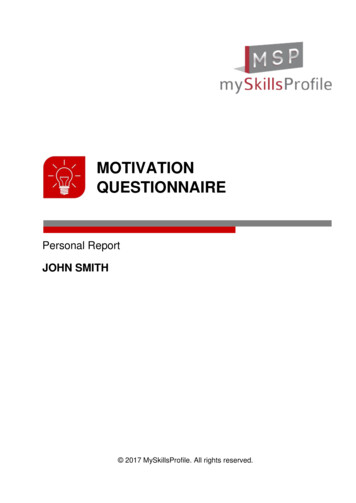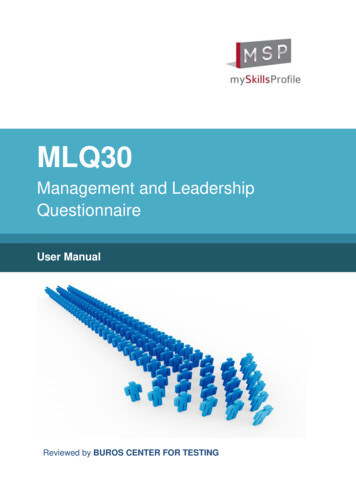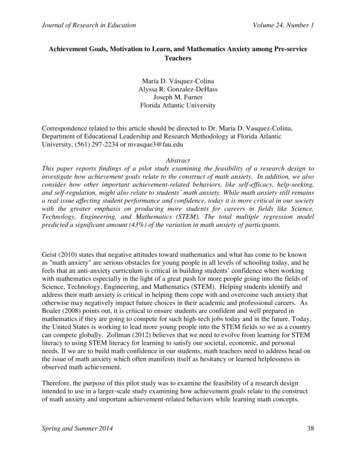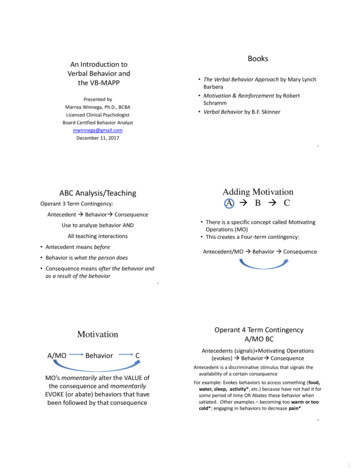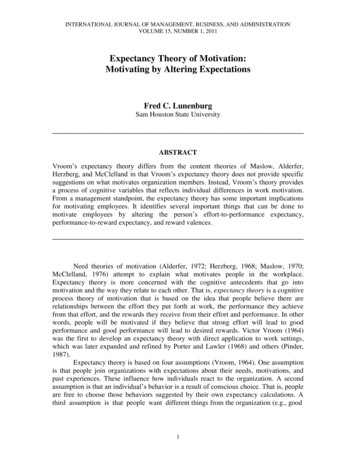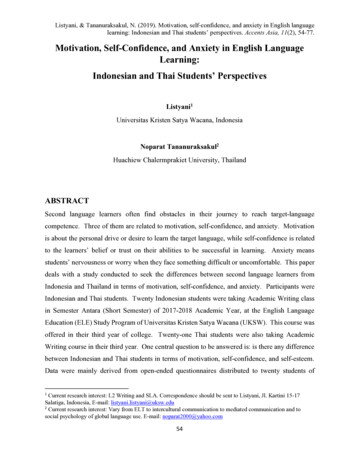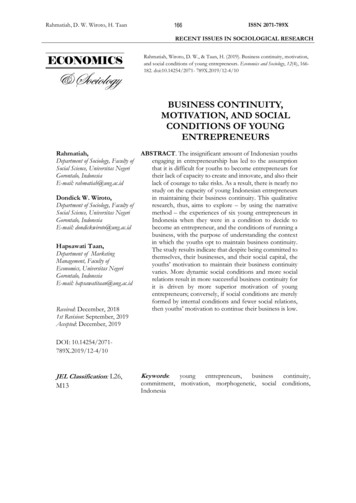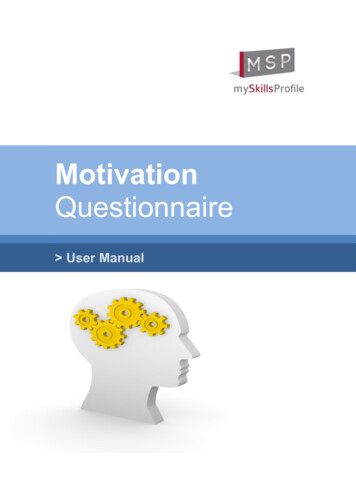
Transcription
MotivationQuestionnaire User Manual
Copyright 2014, MySkillsProfile.com Limited.www.myskillsprofile.com.com.MQ is a trademark of MySkillsProfile.com Limited.All rights reserved. No part of this publication may be reproduced or distributed in anyform or by any means or stored in a database or retrieval system without the prior writtenpermission of MySkillsProfile.com Limited.Page 2
Contents1.2.3.4.5.Introduction 41.1Purpose of MQ 41.2What the MQ Measures 51.3Development of the MQ 51.4Model of Work Motivation 71.5Motivation and Performance 8Applications and Administration 92.1Applications 92.2Administration 92.3Norming 102.4Good Practice 10Scale Descriptions 113.1Overview 113.2Interpreting Scores 11Reliability and Validity 334.1Internal Consistency Reliability 334.2Scale Intercorrelations 344.3Standard Error of Difference 344.4Factor Analysis 344.5Criterion Validity 384.6Demographics 41Norms 43References 46Page 3
1. IntroductionThis User Manual gives an overview of the application, administration, interpretation andreliability and validity of the MQ motivation assessment test. Evidence for the reliability andvalidity is presented against some of the key the criteria in the EFPA Review Model for theDescription and Evaluation of Psychological Tests (Bartram, 2002). The EFPA ReviewModel was produced to support and encourage the process of harmonizing the reviewing oftests. It provides a standard set of criteria to assess the quality of tests. These cover thecommon areas of test review such as norms, reliability and validity.1.1Purpose of MQThe MQ questionnaire was designed to throw light on what motivates and demotivatespeople at work. The MQ motivation model is based on twenty motivation dimensions thatoccur repeatedly in the literature on motivation. These cover key areas in motivationframeworks including the three key areas of Ryan and Deci’s (2002) Self-DeterminationTheory--Autonomy, Relatedness, and Competence (Figure 1).Figure 1. MQ Concept Model of MotivationFACTORFACET/DIMENSION AUTONOMY RELATEDNESS COMPETENCE Interest Ethics Growth Flexibility Independence Achievement Business Pressure Customers Activity Management Competition Teamwork Power Status Progression Recognition Fear of Failure Remuneration Job SecurityPage 4
1.2What the MQ MeasuresThe MQ requires a test taker to rate how far different work-related issues affect howmotivated they feel using a five-point Likert scale ranging from “Greatly increases” to“Greatly reduces.” The questionnaire consists of 120 statements (6 items per scale). Mosttest takers complete the test in about 10 minutes. Table 1 defines what each of the MQmotivation scales measure.GreatlyincreasesTends to increaseHas no effectTends to reduceGreatly reducesExample ItemHaving the freedom to try out my own ideasThe MQ also measures an individual’s satisfaction with their current work by asking them toevaluate how far their current job meets different motivation needs and demands.Very great extentGreat extentModerate extentSome extentNot at allExample ItemHaving a lot to do, being on the go, staying busy all the time.These items are used to evaluate the extent to which the respondent’s current job positionmatches their motivation needs and preferences.1.3Development of the MQThe development of the MQ took place in several distinct phases.Phase 1. The first development phase comprised a literature review. The purpose of thereview was to gather information to help build a rich picture of the things that tend tomotivate and demotivate people at work. The information was gathered from a range ofsources including books, magazines, academic articles, websites, and blog posts. Theoutput from the literature review was a list of possible motivational issues and factorsrecorded on a spreadsheet. These were transcribed onto cards.Phase 2. In the second phase, our goal was to create a draft motivation framework. Weused open card sorting to generate possible motivation categories and elements which weretranscribed onto spreadsheets. After numerous iterations, the output from this work streamwas a motivation framework covering twenty areas with each area having six elements.Phase 3. In the third phase of the development of the inventory, we transformed themotivation framework into the format of a typical behavioral style assessment test, and madethis available on our website as a free online assessment with a basic feedback report. Inthe online questionnaire, the motivation elements are presented in random order, andrespondents rate their importance using the five-point rating scale above.After completing the assessment, respondents were asked to complete a personal detailsform that covered gender, age, ethnicity, nationality, employment, and job performance. Weanalyzed data from the free assessment at regular intervals using reliability analysis, andmade changes to items in order to improve the reliability and factor structure of the scales.Page 5
We conducted Exploratory Factor Analysis (EFA) of the motivation scales and the initialanalyses with the extraction of factors based on eigenvalues over 1 produced a four-factorsolution. This was reported in the first version of the user manual and the first version of thefeedback report. The first commercial version of the MQ was published as an onlineassessment in 2004 on MySkillsProfile’s e-testing platform.Table 1. MQ Motivation ScalesDimensionDefinitionInterestVaried, stimulating and creative job objectives and work activities.EthicsWorking in accordance with ethical standards and personal principles.GrowthOpportunities to acquire new knowledge and skills, reachpersonal potential.FlexibilityAccommodating bosses, hours and working conditions.IndependenceFreedom and discretion to decide how to carry out work.AchievementTesting job objectives, demanding responsibilities, new challenges.BusinessWorking in the business sector rather than public service.PressureHandling competing priorities, facing tight deadlines, managingsetbacks and stress.Dealing directly with customers and suppliers, handling problems Having a lot to do, being on the go, staying busy all the time.Supervising other people’s tasks, performance and personaldevelopment.Working in a competitive environment, striving to be the best,wanting to win.TeamworkOperating as part of a team rather than as an individual contributor.PowerBeing in charge, exercising control, having responsibility for peopleand resources.Deriving standing and feelings of importance from work and jobseniority.StatusProgressionOpportunity to continually advance to more senior positions.RecognitionAcknowledgment by bosses and colleagues of efforts, skills andcompetencies.Not wanting to let self and others down, being able to prove otherswrong.Fear of FailureRemunerationOpportunity to boost earnings related to job performance.Job SecuritySecure, permanent and reliable job position.Page 6
Phase 4. In 2014, we carried out a review of the MQ. Our goal was to update the usermanual for review, and publish a new feedback report with practical tips and suggestions forperformance improvement. Exploratory Factor Analysis (EFA) was carried out following bestpractice identified by Costello and Osborme (2005). Instead of using eigenvalues over 1 asthe determining factor, we examined the graph of the eigenvalues and carried out three,four, and five-factor extractions.We judged that a three-factor solution had the “cleanest” factor structure judged by thestrength of loadings and the number of cross-loadings on each factor--that is, item loadingsof at least 0.45, few item cross-loadings, and no factors with fewer than three items. Thepattern of loadings on the factors led us to conclude that the three factors were related to thethree key areas of Self-Determination Theory. Chapter 5 provides details of the three-factorsolutions.It is important to recognize that many of the motivation factors and elements that theinstrument assesses are not unique to the MQ, and the motivation characteristics that theycapture can be seen in other motivation models and measures.1.4Model of Work MotivationFigure 2 shows the MQ factor model of work motivation that emerged from EFA. The scalesshown under each factor are those that loaded at 0.3 or higher in the rotated componentsolution.Figure 2. Three Factor Model of Work onIndependenceCompetitionFear of FailureAchievementTeamworkRemunerationBusinessJob SecurityAutonomy. Seven scales load on the Autonomy factor. According to Ryan and Deci,Autonomy concerns the experience of acting with a sense of choice, will, and selfdetermination. When people are intrinsically motivated through Autonomy, they feel theyhave options and choices, and the opportunity to carry out their work activities in differentways. They do not feel controlled or compelled by their managers or team mates to do thingsin certain ways. Autonomy leads to “sustainable motivation”, according to Ryan and Deci,Page 7
because it emerges from one‘s sense of self, and it produces feelings of willingness andengagement.Respondents who have high scores on the MQ Autonomy factor are motivated when theyfeel they have interesting work; they work in accordance with ethical standards and personalprinciples; there are opportunities to acquire new knowledge and skills; there areaccommodating bosses, hours, and working conditions; there is freedom and discretion todecide how to carry out work; and, they face testing job objectives, demandingresponsibilities, and new challenges. People who score high on the MQ Autonomy factoralso display a slight preference for working in the business sector rather than public service.Relatedness. According to Self-Determination Theory, Relatedness is the experience ofhaving satisfying and supportive social relationships at work and outside it. The MQRelatedness factor is a broad factor that measures many different characteristics ofrelationship interaction and affiliation. People who get high scores on this factor like having alot to do, and having to manage pressure and stress; they enjoy dealing with customers andsuppliers; they get satisfaction from being in management and leadership positions andbeing responsible for people; they are motivated by the opportunity to compete against theirpeers; and, they prefer to operate as part of a team rather than as an individual contributor.Competence. In Self-Determination Theory, Competence is the belief that one has theability to influence important outcomes. The MQ Competence factor measures sevendimensions that contribute to how able, capable, and competent people feel. People whoobtain high scores on this factor are people who enjoy being in charge and having powerand status; work gives them standing and makes them feel respected; they value theopportunity to advance to more senior positions; acknowledgment by bosses is important tothem; succeeding and not failing in front of their peers matter to them; and, they prefer itwhen earnings are related to performance. They also have a slight preference foremployment that is secure/permanent.1.5Job PerformanceA key success criterion for any occupational measure is whether the results help predict jobperformance. There is a large body of evidence about the contributions of general mentalability (GMA), personality, and experience to job performance. For example, Schmidt andHunter (2004) report that GMA correlates above 0.5 with job performance, personalitycorrelates at about 0.3, and experience correlates at about 0.2. There is much less dataabout the impact of motivation factors such autonomy, relatedness, and competence on jobperformance.At the end of the online questionnaire, there is an optional form where respondents areasked to provide information about their job performance. Respondents are asked to assesstheir performance over the last year using a four point scale from excellent to unsatisfactory.Using the same scale, respondents are also asked to report how their line managers ratedtheir performance. We used this information to look at the relationship between the MQscales and job performance.Our analysis suggests that motivation needs and preferences predict the types of jobspeople seek and how they perform, but the impact is modest in comparison to the effects ofGMA, and less significant than the effects of personality and experience.Page 8
2. Applications and Administration2.1ApplicationsThe MQ questionnaire is suitable for a range of assessment and development applicationsincluding selection, coaching, training, team building and career counselling.Selection. MQ interp
1.2 What the MQ Measures The MQ requires a test taker to rate how far different work-related issues affect how motivated they feel using a five-point Likert scale ranging from “Greatly increases” to “Greatly reduces.” The questionnaire consists of 120 statements (6 items per scale). Most test takers complete the test in about 10 minutes. Table 1 defines what each of the MQFile Size: 1023KBPage Count: 48
